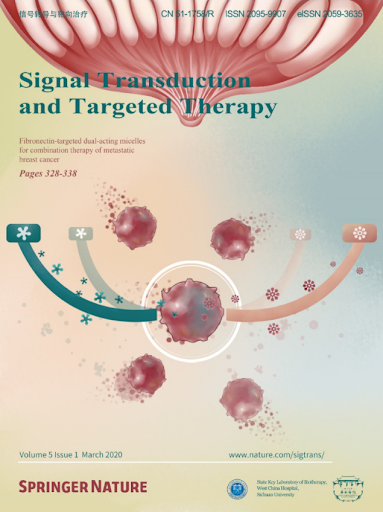Ultrasound activated herbal bio-heterojunctions for self-catalytic regulation and bacterial cuproptosis-like death in the treatment of implant infection.
IF 52.7
1区 医学
Q1 BIOCHEMISTRY & MOLECULAR BIOLOGY
引用次数: 0
Abstract
Conventional antibiotic strategies often fail to consistently suppress escaping planktonic bacteria and even induce antibiotic resistance, allowing implant-associated infections (IAIs) to persist. In this study, we demonstrated an antibiotic-free coating engineered with an herbal bioheterojunction featuring a shell-in-shell structure where Cu2O forms the core, strontium (Sr) is loaded in the inner shell, and curcumin (Cur) is nucleated in situ at the outer heterointerface (Cu2O-Sr/Cur). Ultrasound-triggered reactive oxygen species (ROS) generation by the outer heterostructure (Cu2O/Cur), coupled with Cu(I)-induced cuproptosis-like bacterial death, achieved antibacterial rates of 99.56% against S. aureus and 99.43% against E. coli. When ultrasonication ceases, the released Cu(I) undergoes disproportionation reactions to form Cu(II), which can chelate with Cur to form Cu-Cur metal complexes. These complexes exhibit enhanced antioxidative properties through self-catalytic regulation, the scavenging of ROS, and the activation of anti-inflammatory M2 macrophage phenotype. Moreover, strontium release from the inner shell simultaneously suppressed osteoclast activity and promoted osteogenesis, resulting in trabecular number and thickness increases of 129.03% and 56.71%, respectively, compared with those in control group. Therefore, our work establishes a sequential treatment strategy for the antibacterial properties and osteointegration ability of IAIs.超声激活草药生物异质结自催化调节和细菌铜裂样死亡治疗种植体感染。
传统的抗生素策略往往不能持续抑制浮游细菌的逃逸,甚至诱发抗生素耐药性,使植入物相关感染(IAIs)持续存在。在这项研究中,我们展示了一种无抗生素涂层,该涂层采用草药生物异质结工程设计,具有壳中壳结构,其中Cu2O形成核心,锶(Sr)装载在内壳中,姜黄素(Cur)在外部异质界面(Cu2O-Sr/Cur)原位成核。超声触发的外部异质结构(Cu2O/Cur)产生的活性氧(ROS),加上Cu(I)诱导的铜中毒样细菌死亡,对金黄色葡萄球菌和大肠杆菌的抗菌率分别为99.56%和99.43%。当超声作用停止时,释放的Cu(I)发生歧化反应生成Cu(II), Cu(II)可与Cur螯合形成Cu-Cur金属配合物。这些复合物通过自催化调节、清除ROS和激活抗炎M2巨噬细胞表型表现出增强的抗氧化特性。此外,内壳释放锶同时抑制破骨细胞活性和促进成骨,导致骨小梁数量和厚度分别比对照组增加129.03%和56.71%。因此,我们的工作建立了iai抗菌性能和骨整合能力的顺序治疗策略。
本文章由计算机程序翻译,如有差异,请以英文原文为准。
求助全文
约1分钟内获得全文
求助全文
来源期刊

Signal Transduction and Targeted Therapy
Biochemistry, Genetics and Molecular Biology-Genetics
CiteScore
44.50
自引率
1.50%
发文量
384
审稿时长
5 weeks
期刊介绍:
Signal Transduction and Targeted Therapy is an open access journal that focuses on timely publication of cutting-edge discoveries and advancements in basic science and clinical research related to signal transduction and targeted therapy.
Scope: The journal covers research on major human diseases, including, but not limited to:
Cancer,Cardiovascular diseases,Autoimmune diseases,Nervous system diseases.
 求助内容:
求助内容: 应助结果提醒方式:
应助结果提醒方式:


